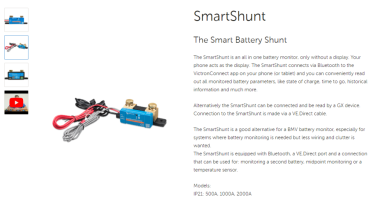My converter fitted my van with a very basic 4-LED battery test panel to monitor my led-acid batter. I wanted more data.
I first bought a Renogy Battery Monitor. It seemed to monitor the current and voltage accurately, but the state of charge was always wrong. It would show 100% nearly all the time, and then would suddenly give me a low voltage alert. I believed the monitor to be faulty.
I then bought a Victron Smart Shunt, and this appeared to be working more reliably. Current and voltage seemed accurate and I thought the problem was resolved.
Then I found my leisure battery to be failing. Monitor would say 100% and voltage of 12.7-ish and yet the fridge and diesel heater would often not run. Voltage would plummet when either of them turned on, and they would fail to operate.
I replaced my led-acid battery with a new Renogy Lithium, and the bluetooth module seemed an obvious choice.
I now see a discrepancy between the Victron smart shunt and the Renogy lithium battery. The battery will show 93% whilst the shunt says 100%. Current and voltage appear to match, but maybe I need to scrutinise the current and test this more.
My questions:
1) Why? There must be draw on the battery that is not being picked up by the shunt. Would this be something that is connected to my positive terminal, but grounded elsewhere? Eg. Not connected to the negative terminal?
2) I take good care of my van, and I carefully monitor my leisure battery. Perhaps I've inadvertently killed the leisure battery when I believed it to be at a higher SOC than it was?! What voltage should a healthy led-acid leisure battery show when fully charged? Mine was always at around 12.7 fully charged. Am I right that this battery still appears to be faulty? If at 12.7v at rest, but unable to run the fridge or diesel heater?
Would love to hear any insights.
I first bought a Renogy Battery Monitor. It seemed to monitor the current and voltage accurately, but the state of charge was always wrong. It would show 100% nearly all the time, and then would suddenly give me a low voltage alert. I believed the monitor to be faulty.
I then bought a Victron Smart Shunt, and this appeared to be working more reliably. Current and voltage seemed accurate and I thought the problem was resolved.
Then I found my leisure battery to be failing. Monitor would say 100% and voltage of 12.7-ish and yet the fridge and diesel heater would often not run. Voltage would plummet when either of them turned on, and they would fail to operate.
I replaced my led-acid battery with a new Renogy Lithium, and the bluetooth module seemed an obvious choice.
I now see a discrepancy between the Victron smart shunt and the Renogy lithium battery. The battery will show 93% whilst the shunt says 100%. Current and voltage appear to match, but maybe I need to scrutinise the current and test this more.
My questions:
1) Why? There must be draw on the battery that is not being picked up by the shunt. Would this be something that is connected to my positive terminal, but grounded elsewhere? Eg. Not connected to the negative terminal?
2) I take good care of my van, and I carefully monitor my leisure battery. Perhaps I've inadvertently killed the leisure battery when I believed it to be at a higher SOC than it was?! What voltage should a healthy led-acid leisure battery show when fully charged? Mine was always at around 12.7 fully charged. Am I right that this battery still appears to be faulty? If at 12.7v at rest, but unable to run the fridge or diesel heater?
Would love to hear any insights.
Last edited:

